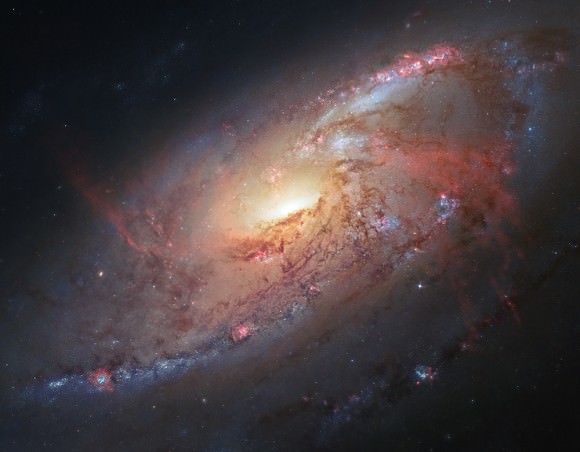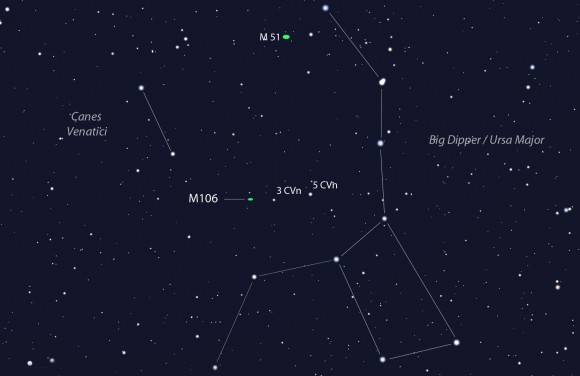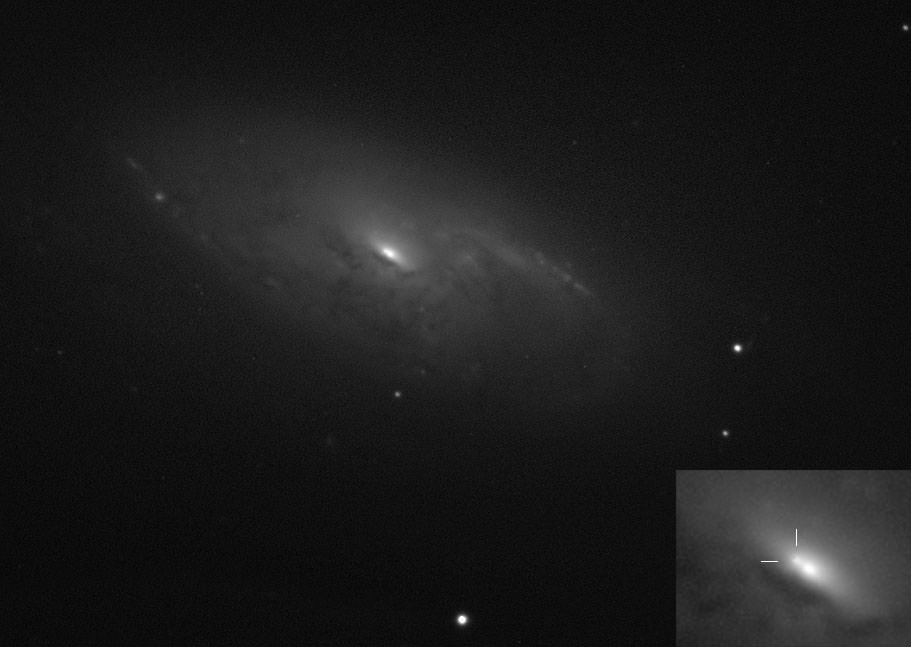A supergiant star exploded 23.5 million years ago in one of the largest and brightest nearby galaxies. This spring we finally got the news. In April, the Katzman Automatic Imaging Telescope (KAIT) as part of the Lick Observatory Supernova Search, photographed a faint “new star” very close to the bright core of M106, a 9th magnitude galaxy in Canes Venatici the Hunting Dogs.

A study of its light curve indicated a Type II supernova – the signature of a rare supergiant star ending its life in the most violent way imaginable. A typical supergiant star is 8 to 12 times more massive than the sun and burns at a much hotter temperature, rapidly using up its available fuel supply as it cooks lighter elements like hydrogen and helium into heavier elements within its core. Supergiant lifetimes are measured in the millions of years (10-100 million) compared to the frugal sun’s 11 billion years. When silicon fuses to create iron, a supergiant reaches the end of the line – iron can’t be fused or cooked into another heavier element – and its internal “furnace” shuts down. Gravity takes over and the whole works collapses in upon itself at speeds up to 45,000 miles per second.
When the outer layers reached the core, they crushed it into a dense ball of subatomic particles and send a powerful shock wave back towards the surface that rips the star to shreds. A supernova is born! Newly-minted radioactive forms of elements like nickel and cobalt are created by the tremendous pressure and heat of the explosion. Their rapid decay into stable forms releases energy that contributes to the supernova’s light.

For two weeks, the supernova in M106 remained pinned at around magnitude +15, too faint to tease out from the galaxy’s bright, compact nucleus for most amateur telescopes. But a photograph taken by Gianluca Masi and team on May 21 indicate it may have brightened somewhat. They estimated its red magnitude – how bright it appears when photographed through a red filter – at +13.5. A spectrum made of the object reveals the ruby emission of hydrogen light, the telltale signature of a Type II supernova event.

Visually the supernova will appear fainter because our eyes are more sensitive to light in the middle of the rainbow spectrum (green-yellow) than the reds and purple that bracket either side. I made a tentative observation of the object last night using a 15-inch (37-cm) telescope and hope to see it more clearly tonight from a darker sky. We’ll keep you updated on our new visitor’s brightness as more observations and photographs come in. You can also check Dave Bishop’s Latest Supernovae site for more information and current images.
Even if the supernova never gets bright enough to see in your telescope, stop by M106 anyway. It’s big, easy to find and shows lots of interesting structure. Spanning 80,000 light years in diameter, M106 would be faintly visible with the naked eye were it as close as the Andromeda Galaxy. In smaller scopes the galaxy’s bright nucleus stands out in a mottled haze of pearly light; 8-inch(20-cm) and larger instrument reveal the two most prominent spiral arms. M106 is often passed up for the nearby more famous Whirlpool Galaxy (M51). Next time, take the detour. You won’t be disappointed.

